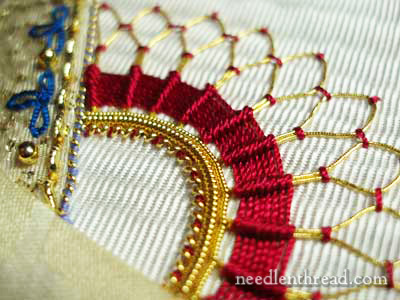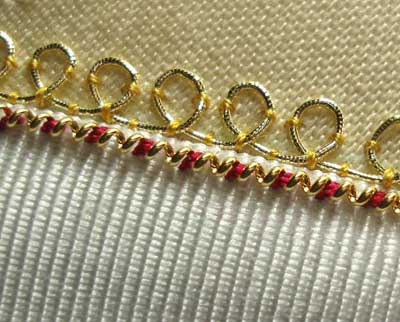As a follow up on how to use pearl purl, here’s another option for this beautiful real metal thread. It still involves couching, but for this technique, you use a colored embroidery thread.
When you stretch pearl purl, the coils open and it looks even more like a spring. The gold thread (I always have a problem calling goldwork threads “threads” for some reason!) has nice spaces between the coils for couching, and if you couch in every other coil, you can achieve a different and interesting effect.

Although I already showed you this little motif when I was discussing goldwork on a crazy quilt square, I thought it worth while to bring it up again, to demonstrate what you can do with stretched pearl purl, and to show you how it looks next to regular pearl purl.
In the photo above, the last inside circle at the base of the motif is stretched pearl purl, couched in every-other-coil with red silk buttonhole twist. Directly above the stretched pearl purl is pearl purl #3, and above that, pearl purl size #F1.
To use stretched pearl purl, cut about half the length you need for the line you want to cover.
To stretch, grip each end of the pearl purl with your fingernails (well, I find it easiest to use my nails between the last coil or two). Pull gently with consistent pressure from both hands until the pearl purl has doubled in length.

If you have coils on the end that are still closed, either stretch them or cut them off. Make sure that your length of pearl purl covers the line you want to cover, though, before you cut!! Once you’ve determined that you have the right length (or a little longer, even) than you need, you can thread your needle and get ready to couch.
Silk buttonhole twist worked really well here. You can use heavier threads, too, like Trebizond, or you can use regular stranded floss – but you’ll probably need three strands or more for the color to show up well. Thread your needle and anchor it (either using a waste knot, or running it under threads already there). Bring your needle to the front of your fabric at the point you want your line to begin, and stitch over the first “valley” after the first coil. Then skip a valley, and stitch in the next. Continue stitching in every other valley between the coils until you reach the end of the line. Try to end with a couching stitch.
If you need to snip your gold to fit the line, snip it, then take your couching thread to the back and run it under the stitches on the back to secure it.
This is a very simple technique, and makes a really pretty line of gold, accented by whatever color you choose for a couching thread.
Another tip: though I usually will always wax a regular couching thread when I’m working with pearl purl, when I’m using the floss as a decoration (as in this technique) I don’t wax the thread. The thread just looks better when it isn’t waxed!
So, if you’re game for goldwork, here’s an easy technique to try!
Have fun with it!







What are those fabulous fabrics shown here that you are stitching on? I’m just starting out with some really good pieces and I don’t like how things have come out on my cotton backgrounds. Please let me know what fabrics you use for pieces that you want to become “family heirlooms”. Thanks!
Hi, Kathy – this was a combination of different fabrics on a crazy quilt square, so it’s silks, brocades, etc. If you’re doing a regular piece of embroidery (not a CQ square) that you want to be an heirloom, I’d suggest natural fibers – linen or silk – and if silk, to use a good silk, like a silk satin or a very good dupioni or something similar. (There are cheap, flimsy dupionis out there that are not that great for stitching on – you want something with a bit of body to it.) Good linen is always a good choice, too, because it will withstand the test of time.